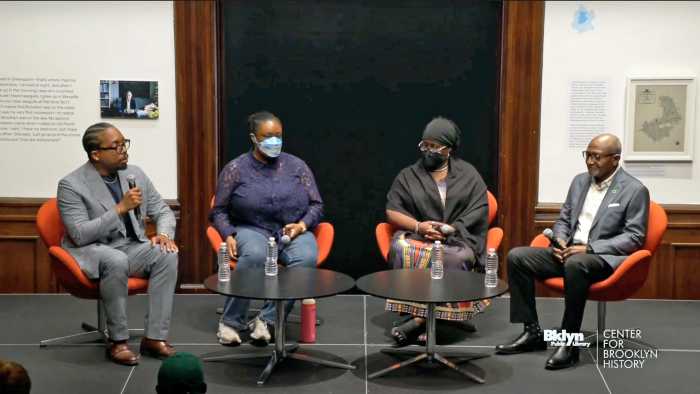BY DAVID KENNERLEY | “Speakeasy: John and Jane’s Adventures in the Wonderland” is one of the most wildly ambitious, inspired theatrical endeavors I’ve seen on an Off Off Broadway stage. Bursting with an excess of ideas and passion, there’s nothing remotely easy about it.
Hatched from the fertile, fervid mind of Danny Ashkenasi, “Speakeasy” shines a light on New York City’s queer culture that briefly emerged from the shadows during the Prohibition era, circa 1930, known as the Pansy Craze.
The central thread is a love story — three love stories, actually — between bright-eyed newlyweds John (Matias Polar) and Jane (Kayleigh Shuler), who succumb to forbidden longings. John is smitten by a female impersonator (Tim Connell) inspired by Julian Eltinge, a hugely popular drag performer on Vaudeville, Broadway, and in Hollywood. Jane is sweet on a stocky, white-tuxedoed performer (Camille Atkinson) based on Gladys Bentley, an openly lesbian blues singer during the Harlem Renaissance.
Manic mashup of Prohibition-era queer history, “Alice in Wonderland,” and a zillion other things
But Ashkenasi is not content to stop there. He has slathered on a thick, gooey layer of magical realism, borrowing heavily from Lewis Carroll’s “Alice in Wonderland” stories. After a chance sloppy kiss from a close female friend (and a swig of hooch), Jane falls down the proverbial rabbit hole, and John, after a random blowjob in a men’s room stall, passes through the looking glass.
A dizzying, confounding epic fever dream ensues, where they meet oddballs like crooner Chet Cheshire (Bri Molloy) and the chirpy, dancing Tweedle sisters (Allie Radice and Anne Bragg).
Oh, and did I mention “Speakeasy” is a musical? The program lists no less than 40 musical numbers, many with full-blown choreography (by J. Alan Hanna). Wonderland, as it happens, is the name of a racy, queer speakeasy in Harlem where illicit liquor flows and inhibitions melt away.
The massive ensemble of 23 does its best to bring this dreamscape to life. Clocking in at nearly 4 hours including intermission (it ran about 45 minutes over), this gutsy production has bitten off way more than it can chew. The book is simply too bloated, and many scenes and songs are redundant. Granted, I saw the first and only preview performance, but clearly cuts should have been made weeks ago. Director Lissa Moira, who conjures some wonderful moments, should have sharpened her scissors and used them without mercy.
“Speakeasy” is at its best during the musical numbers (Ashkenasi wrote the music and lyrics as well as the book). Under the musical direction of Jonathan Fox Powers, the score is an appealing mix of period jazz, swing, cabaret, Tin Pan Alley, and operetta. The lyrics, melodies, and orchestrations are surprisingly rich and sophisticated for such a shoestring production.
No less compelling is the attention to historical detail. Dialogue is meticulously sprinkled with colorful period queer slang, like “dropping pins” (hinting about one’s homosexuality), “Vaseline Alley” (the Southeast corner of Central Park where the fairies gathered), “basketeering” (ogling a guy’s crotch), and “browning” (I’ll let you figure that one out). The piece keenly illustrates that liquor was once blamed for the ills of society, but after Prohibition was repealed, the vice police decided the new enemy was the “moral degenerates” such as queers.
There’s even a steamy orgy scene set at the notorious Everard Baths, though it was unnecessary, since there’s another racy sex scene soon after it. What’s more, the historically based narrative is so weirdly captivating on its own, I’m not sure it needs the hackneyed “Alice in Wonderland” spin at all.
If the objective was to deliver an offbeat, mind-blowing fantasia on identity, taboo romance, and queer culture circa 1930, then “Speakeasy” has succeeded in the extreme. An equally vital goal, however, is coaxing audience members back into their seats after intermission. On that score, this well-intentioned, overwrought endeavor still has plenty of work to do.
SPEAKEASY | Theater for the New City, 155 First Ave., btwn. Ninth & Tenth Sts. | Through Mar. 13: Wed.-Sat. at 8 p.m.; Sat. at 2 p.m., Sun. at 3 p.m. | $18 at theaterforthenewcity.net | Three hrs., 45 min., with intermission


































